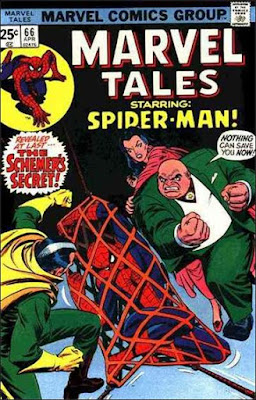Origins of the Bronze Age of Spider-Man
Origins of the Bronze Age: The comic that kicks off this blog was my favorite when I was seven years old: a copy of a 1976 issue of Marvel Tales Featuring Spider-Man that came out the week of my second birthday. Its story featured the End of the Kingpin after three years of terrific battles, which resumed at least every few months in 1967 through 1969, in the pages of Amazing Spider-Man, the original comic book series featuring Spider-Man.
Kingpin of Crime, Wilson Fisk; this normal man without superpowers became Spider-Man’s greatest archenemy of the Silver Age, due in part to his limitless supply of organized criminals. In the Steve Ditko days of colorful super-villains, the Scorpion from Amazing Spider-Man #20, 1965, was designed to be his arch-enemy. Under Ditko, however, from nowhere that arch-foe position became property of the mysterious Green Goblin. When Romita comes aboard with #39, Lee ends the Goblin with first Romita story, but the first Bronze Age Green Goblin story will become the last for both Norman Osborn, the original Green Goblin, and Peter Parker’s girlfriend Gwen Stacy! Well, as with the end of the Kingpin: originally-speaking, that was the end…
My reading of superhero comics as I recall, in particular Spider-Man, began with Marvel Tales #107, 89, 120, 133 (near end of Bronze Age reprints; about to cycle back to reprinting classic Lee/ Ditko original stories from 1962-1966) and 66; you could get your own copy for a dollar or less. Marvel Tales 133 and 66 were the first ever bought with an allowance, given to reward my good grades in second grade; Dad explained the system and the value of the quarters he gave me, and I spent seventy-five cents eventually on two salvage copies of Spider-Man, probably some Wholesale ID’s unreturned, undestroyed overstock. The 1977-78 live action Spider-Man TV series and cartoon from 1967-1969 provide two of the origins of my love of Spider-Man; in fact, finding there was a comic book featuring the wedding of Betty Brant to someone else, Ned Leeds, gave me a sense the cartoons with her at the Bugle were set in stories in the past, giving the illusion of life moving on.
The other source of origin, and Orange Juice, was my cup, which told the web-slinger’s origin with the same narrative caption that appeared on the top first page of most every Bronze Age issue of Amazing Spider-Man by Marvel Comics Group.
Amazing Spider-Man #83-85, however, is a pretty interesting personal ending to the Silver Age, for me. The tale of the Schemer, new rival to the Kingpin, goes from crime epic to intensely personal story, focused on a small cast. Peter’s lie he lives as Spider-Man drives his girlfriend away and worries her, while the ruse he tries so he can leave them at his apartment begins her father Captain George Stacy’s suspicions…or, the old fellow has it figured out, and feels like telling Peter at the tragic moment that ends his life in Amazing Spider-Man #90. In this lonely, bleak story, Peter fools his visitors the best he can with a bluff, delivered as Spider-Man, who of course he was. Peter’s desperate to throw Captain Stacy off the trail of guessing he and Spider-Man are one man and the same! Lies go on to utterly destroy the Kingpin’s family, however: his new rival’s revealed to be his long-lost son! The action of the story itself slows to a crawl, with Spider-Man captured, listening to the truth from the Schemer---Richard Fisk.
The Death of Captain Stacy, and the last great Stan Lee Doctor Octopus story to boot, a much stronger trilogy of issues, is probably another possible ending to the Silver Age, rather than the later death of Gwen Stacy and the Gobin under Gerry Conway in 1972. Stan Lee still wrote another year of stories, interspersed for the first time with scripts by Roy Thomas that don’t quite nail Spider-man (Savage Land? Nooo…New York City!) before Thomas takes over for about a year. Doctor Octopus is another contender along with Kingpin and Gobbie for Spider-Man’s Silver Age archnemesis.
For me, I became a fan of Spider-Man during the American Comics Bronze Age, which began sometime before I was born and ended about the time I gave up comics for girls (or a broader set of interests in general…obviously, it didn’t stay that way!). Incidentally, I think I’ll end this discussion about the time Spidey marries Mary Jane Watson in both the newspaper and the comics, as the era under editor-in-chief Jim Shooter ends. My three years as a reader of Jim’s Marvel Comics Group gave me a lifelong delight in comic books and Spider-Man in particular that keeps me re-visiting my webheaded friend now and then. I had another three years or so collecting while still a young married college student, and that will be another story to tell one day.
As it is, I’ve still got a few never filled holes, and I’m going to group a lot of multi-part stories into single blog posts. The goal is to work from memory, amidst the other regular work I do, so this is the closest thing to a hobby for me, aside from, I guess, socializing, which is still different.
I’ll bet I won’t be alone, however, in wiggling my webs at least twice weekly!
Long underwear Lue






Comments
Post a Comment